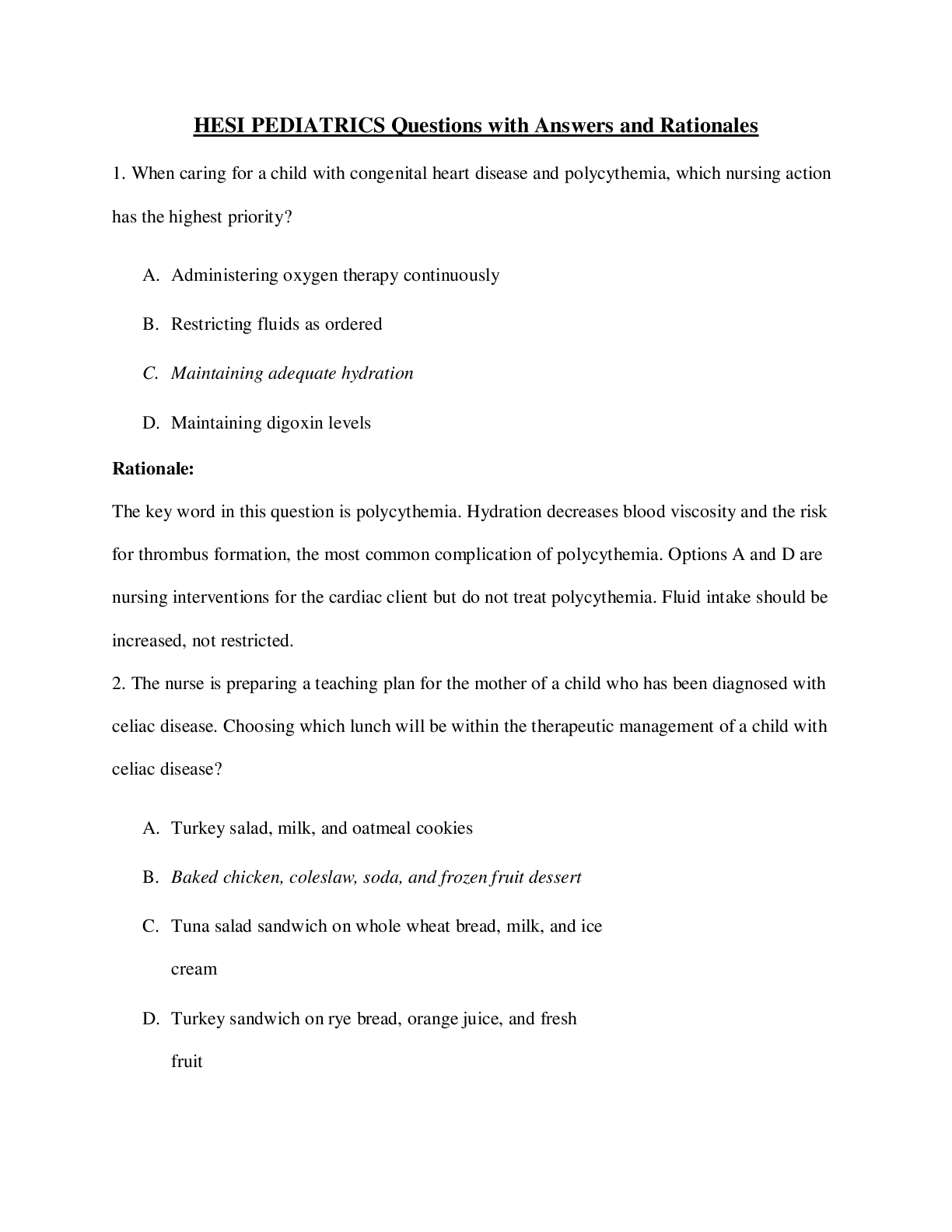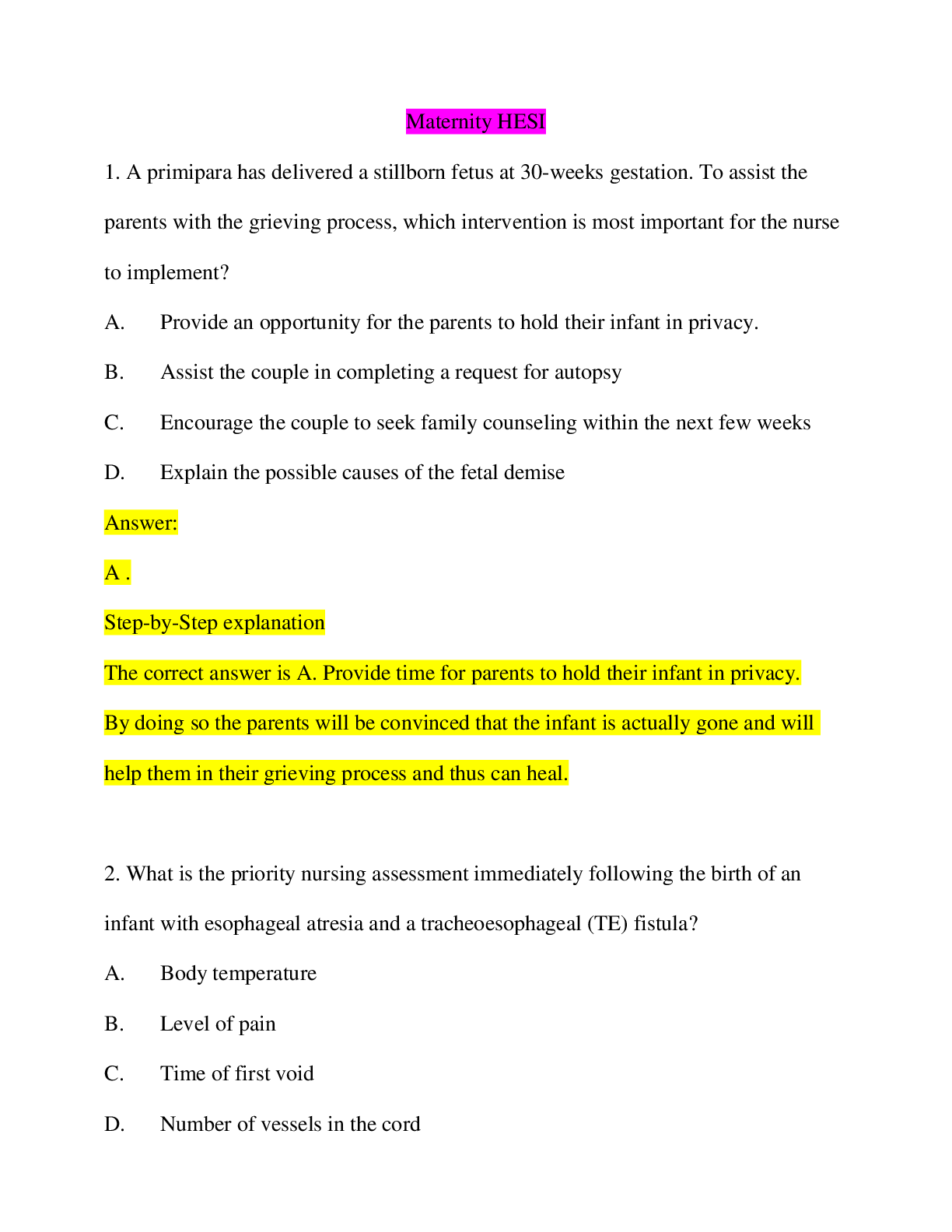Hesi Fundamentals Practice Questions AND ANSWERS EXPLAINED,100% CORRECT
Document Content and Description Below
Fundamentals Hesi 1. The home health nurse visits an elderly female client who had a brain attack three months ago and is now able to ambulate with the assistance of a quad cane. Which assessment fin... ding has the greatest implications for this client's care? • The husband, who is the caregiver, begins to weep when the nurse asks how he is doing. • The client tells the nurse that she does not have much of an appetite today. • The nurse notes that there are numerous scatter rugs throughout the house. • The client's pulse rate is 10 beats higher than it was at the last visit one week ago. 2. The nurse is digitally removing a fecal impaction for a client. The nurse should stop the procedure and take corrective action if which client reaction is noted? • Temperature increases from 98.8° to 99.0° F. • Pulse rate decreases from 78 to 52 beats/min. • Respiratory rate increases from 16 to 24 breaths/min. • Blood pressure increases from 110/84 to 118/88 mm/Hg. 3. The nurse is providing passive range of motion (ROM) exercises to the hip and knee for a client who is unconscious. After supporting the client's knee with one hand, what action should the nurse take next? • Raise the bed to a comfortable working level. • Bend the client's knee. • Move the knee toward the chest as far as it will go. • Cradle the client's heel. 4. A client who has moderate, persistent, chronic neuropathic pain due to diabetic neuropathy takes gabapentin (Neurontin) and ibuprofen (Motrin, Advil) daily. If Step 2 of the World Health Organization (WHO) pain relief ladder is prescribed, which drug protocol should be implemented? • Continue gabapentin. • Discontinue ibuprofen. • Add aspirin to the protocol. • Add oral methadone to the protocol. 5. The nurse is preparing to irrigate a client's indwelling urinary catheter using an open technique. What action should the nurse take after applying gloves? • Empty the client's urinary drainage bag. • Draw up the irrigating solution into the syringe. • Secure the client's catheter to the drainage tubing. • Use aseptic technique to instill the irrigating solution. 6. Which client care requires the nurse to wear barrier gloves as required by the protocol for Standard Precautions? • Removing the empty food tray from a client with a urinary catheter. • Washing and combing the hair of a client with a fractured leg in traction. • Administering oral medications to a cooperative client with a wound infection. • Emptying the urinary catheter drainage bag for a client with Alzheimer's disease. 7. What action should the nurse implement to prevent the formation of a sacral ulcer for a client who is immobile? • Maintain in a lateral position using protective wrist and vest devices. • Position prone with a small pillow below the diaphragm. • Raise the head and knee gatch when lying in a supine position. • Transfer into a wheelchair close to the nurse's station for observation. 8. What intervention should the nurse include in the plan of care for a client who is being treated with an Unna's paste boot for leg ulcers due to chronic venous insufficiency? • Check capillary refill of toes on lower extremity with Unna's paste boot. • Apply dressing to wound area before applying the Unna's paste boot. • Wrap the leg from the knee down towards the foot. • Remove the Unna's paste boot q8h to assess wound healing. 9. The nurse is administering an intermittent infusion of an antibiotic to a client whose intravenous (IV) access is an antecubital saline lock. After the nurse opens the roller clamp on the IV tubing, the alarm on the infusion pump indicates an obstruction. What action should the nurse take first? • Check for a blood return. • Reposition the client's arm. • Remove the IV site dressing. • Flush the lock with saline. 10. A female client who has breast cancer with metastasis to the liver and spine is admitted with constant, severe pain despite around-the-clock use of oxycodone (Percodan) and amitriptyline (Elavil) for pain control at home. During the admission assessment, which information is most important for the nurse to obtain? • Sensory pattern, area, intensity, and nature of the pain. • Trigger points identified by palpation and manual pressure of painful areas. • Schedule and total dosages of drugs currently used for breakthrough pain. • Sympathetic responses consistent with onset of acute pain. 11. A male client is on contact precautions due to an infected draining wound and is being discharged home. The client lives at home with his wife and their adolescent daughter. What discharge instruction should the nurse include for the client? • Use disposable plates and utensils. • Stay in a room with the door closed. • Dispose of soiled dressings in plastic bags that are securely closed. • Others who are in the same room with the client should wear a mask. 12. The nurse is discussing dietary preferences with a client who adheres to a vegan diet. Which dietary supplement should the nurse encourage the client to include the dietary plan? • Fiber. • Folate. • Ascorbic acid. • Vitamin B12. 13. The charge nurse observes that a demographic screen has been left open on a hallway computer by a nurse who is responding to a call light because the unlicensed assistive personnel (UAP) is involved in a personal phone call. Which action should the charge nurse take first? • Page the unit manager to address the situation. • Close the demographic screen on the computer. • Instruct the UAP to end the phone call immediately. • Send a UAP into the client's room to relieve the nurse. 14. A female client informs the nurse that she uses herbal therapies to supplement her diet and manage common ailments. What information should the nurse offer the client about general use of herbal supplements? • Most herbs are toxic or carcinogenic and should be used only when proven effective. • There is no evidence that herbs are safe or effective as compared to conventional supplements in maintaining health. • Herbs should be obtained from manufacturers with a history of quality control of their supplements. • Herbal therapies may mask the symptoms of serious disease, so frequent medical evaluation is required during use. 15. A high school senior is complaining of a persistent cough and admits to smoking 10 to 15 cigarettes daily for the past year. He is convinced that he is hopelessly addicted to tobacco since he tried unsuccessfully to quit smoking last week. Which intervention is best for the nurse to implement? • Encourage the student to associate with non-smokers only while attempting to stop smoking. • Tell the student that he is still young and should continue to try various smoking cessation methods. • Describe cigarette smoking as a habit that requires a strong will to overcome its addictiveness. • Provide the student with the latest research data describing the long-term effects of tobacco use. 16. When making the bed of a client who needs a bed cradle, which action should the nurse include? • Teach the client to call for help before getting out of bed. • Keep both the upper and lower side rails in a raised position. • Keep the bed in the lowest position while changing the sheets. • Drape the top sheet and covers loosely over the bed cradle. 17. A male client with acquired immunodeficiency syndrome (AIDS) develops cryptococcal meningitis and tells the nurse he does not want to be resuscitated if his breathing stops. What action should the nurse implement? • Document the client's request in the medical record. • Ask the client if this decision has been discussed with his healthcare provider. • Inform the client that a written, notarized advance directive, is required to withhold resuscitation efforts. • Advise the client to designate a person to make healthcare decisions when the client is unable to do so. 18. A client is admitted to the hospital with intractable pain. What instruction should the nurse provide the unlicensed assistive personnel (UAP) who is preparing to assist this client with a bed bath? • Take measures to promote as much comfort as possible. • Report any signs of drug addiction to the nurse immediately. • Wait until the client's pain is gone before assisting with personal care. • This client's pain will be difficult to manage, since the cause is unknown. 19. An older client who is able to stand but not to ambulate receives a prescription to be mobilized into a chair as tolerated during each day. What is the best action for the nurse to implement when assisting the client from the bed to the chair? • Use a mechanical lift to transfer from the bed to a chair. • Place a roller board under the client who is sitting on the side of the bed and slide the client to the chair. • Lift the client out of bed to the chair with another staff member using a coordinated effort on the count of three. • Place a transfer belt around the client, assist to stand, and pivot to a chair that is placed at a right angle to the bed. 20. A male client has a nursing diagnosis of "spiritual distress." What intervention is best for the nurse to implement when caring for this client? • Use distraction techniques during times of spiritual stress and crisis. • Reassure the client that his faith will be regained with time and support. • Consult with the staff chaplain and ask that the chaplain visit with the client. • Use reflective listening techniques when the client expresses spiritual doubts. 21. The nurse obtains a BP reading of 100/88 in the right arm of a client whose blood pressure is typically 120/60 in the same arm. What action should the nurse implement first? • Use an electronic sphygmomanometer to take the BP every 30 minutes. • Retake the blood pressure in the same arm, deflating the cuff slowly. • Ask another nurse to recheck the blood pressure to compare results. • Obtain another blood pressure cuff and retake the blood pressure. 22. A client has a nursing diagnosis of, "Spiritual distress related to a loss of hope, secondary to impending death." What intervention is best for the nurse to implement when caring for this client? • Help the client to accept the final stage of life. • Assist and support the client in establishing short-term goals. • Encourage the client to make future plans, even if they are unrealistic. • Instruct the client's family to focus on positive aspects of the client's life. 23. What is the most effective way to implement a teaching plan? • Teach the information that the client wants to learn first. • Present to the client all the information necessary to meet the objectives. • Provide the client with written material to review before teaching sessions. 24. An older female client with rheumatoid arthritis is complaining of severe joint pain that is caused by the weight of the linen on her legs. What action should the nurse implement first? • Apply flannel pajamas to provide warmth. • Administer a PRN dose of ibuprofen. • Perform range of motion exercises in a warm tub. • Drape the sheets over the footboard of the bed. 25. A male nurse is assigned to care for a female Muslim client. When the nurse offers to bathe the client, the client requests that a female nurse perform this task. How should the male nurse respond? • May I ask your daughter to help you with your personal hygiene? • I will ask one of the female nurses to bathe you. • A staff member on the next shift will help you. • I will keep you draped and hand you the supplies as you need them. Fundamentals conti… 1. A female client informs the nurse that she uses herbal therapies to supplement her diet and manage common ailments. What information should the nurse offer the client about general use of herbal supplements? • Most herbs are toxic or carcinogenic and should be used only when proven effective. • There is no evidence that herbs are safe or effective as compared to conventional supplements in maintaining health. • Herbs should be obtained from manufacturers with a history of quality control of their supplements. • Herbal therapies may mask the symptoms of serious disease, so frequent medical evaluation is required during use. 2. A client is admitted with a stage four pressure ulcer that has a black, hardened surface and a light-pink wound bed with a malodorous green drainage. Which dressing is best for the nurse to use first? • Hydrogel. • Exudate absorber. • Wet to moist dressing. • Transparent adhesive film. 3. When preparing to insert an indwelling urinary catheter, the nurse applies sterile gloves and then tests the catheter balloon for patency. What action should the nurse implement next? • Place a sterile drape under the client's buttocks. • Instruct the client to inhale and then exhale slowly. • Discard the gloves and apply new sterile gloves. • Apply a sterile lubricant to the end of the catheter. 4. The nurse is teaching a client how to self-administer a subcutaneous injection. To help ensure sterility of the procedure, which subject is most important for the nurse to include in the teaching plan? • Hand washing prior to preparation of the injection. • Method used to aspirate medication from a vial. • Selection and rotation of injection sites. • Proper disposal of injection equipment. 5. A nurse observes a student nurse taking a copy of a client's medication administration record. When questioned, the student states, Another student is scheduled to administer medications for this client tomorrow, so I am going to make a copy to help my friend prepare for tomorrow's clinical. What response should the nurse provide first? • Ask the nursing supervisor to meet with the students. • Notify the student's clinical instructor of the situation. • Ask the student if permission was obtained from the client. • Explain that the records are hospital property and may not be removed. 6. Which action should the nurse implement when using the confrontation technique during a vision exam? • Use an ophthalmoscope to watch the client's pupil constrict when a strong light is shown on it. Incorrect • Stand behind the client and direct the client to tell the nurse when an object enters the peripheral field of vision. • Show the client a series of four cards with printing of varying sizes and ask which card the client sees most clearly. • Sit facing the client and while look directly at the client's face, move an object inward from the periphery. 7. What action should the nurse implement to prevent the formation of a sacral ulcer for a client who is immobile? • Maintain in a lateral position using protective wrist and vest devices. • Position prone with a small pillow below the diaphragm. • Raise the head and knee gatch when lying in a supine position. • Transfer into a wheelchair close to the nurse's station for observation. 8. When culturing a wound, the nurse should obtain the sample from which part of the wound? • The outer edges of the wound. • All necrotic sections of the wound. • Areas containing purulent or pooled exudates. • Any particularly painful area of the wound. 9. Before administering a client's medication, the nurse assesses a change in the client's condition and decides to withhold the medication until consulting with the healthcare provider. After consultation with the healthcare provider, the dose of the medication is changed and the nurse administers the newly prescribed dose an hour later than the originally scheduled time. What action should the nurse implement in response to this situation? • Notify the charge nurse that a medication error occurred. • Submit a medication variance report to the supervisor. • Document the events that occurred in the nurses' notes. • Discard the original medication administration record. 10. A healthcare provider is performing a sterile procedure at a client's bedside. Near the end of the procedure, the nurse observes the healthcare provider contaminate a sterile glove and the sterile field. What is the best action for the nurse to implement? • Report the healthcare provider for the violation in aseptic technique. • Allow the completion of the procedure. • Ask if the glove and sterile field are contaminated. • Identify the break in surgical asepsis and provide another set of sterile supplies. 11. The nurse is caring for a client who is weak from inactivity because of a 2-week hospitalization. In planning care for the client, the nurse should include which range of motion (ROM) exercises? • Passive ROM exercises to all joints on all extremities four times a day. • Active ROM exercises to both arms and legs two or three times a day. • Active ROM exercises with weights twice a day with 20 repetitions each. • Passive ROM exercises to the point of resistance and slightly beyond. 12. A male client is on contact precautions due to an infected draining wound and is being discharged home. The client lives at home with his wife and their adolescent daughter. What discharge instruction should the nurse include for the client? • Use disposable plates and utensils. • Stay in a room with the door closed. • Dispose of soiled dressings in plastic bags that are securely closed. • Others who are in the same room with the client should wear a mask. 13. A 35-year-old female client with cancer refuses to allow the nurse to insert an IV for a scheduled chemotherapy treatment, and states that she is ready to go home to die. What intervention should the nurse initiate? • Review the client's medical record for an advance directive. • Determine if a do-not-resuscitate prescription has been obtained. • Document that the client is being discharged against medical advice. • Evaluate the client's mental status for competence to refuse treatment. 14. What is the most effective way to implement a teaching plan? • Teach the information that the client wants to learn first. • Streamline the teaching plan to include only essential information. • Present to the client all the information necessary to meet the objectives. • Provide the client with written material to review before teaching sessions. 15. A client is receiving an intramuscular injection at the ventrogluteal site. At what angle should the nurse insert the needle? (Enter numerical value only.) 90 16. A client who has been on bedrest for several days now has a prescription to progress activity as tolerated. When the nurse assists the client out of bed for the first time, the client becomes dizzy. What action should the nurse implement? • Encourage the client to take several slow, deep breaths while ambulating. • Help the client to remain standing by the bedside until the dizziness is relieved. • Instruct the client to remain on bedrest until the healthcare provider is contacted. • Advise the client to sit on the side of the bed for a few minutes before standing again. 17. When examining the wound of a client who had abdominal surgery yesterday, the nurse finds that the wound edges are close together, there is no sign of redness, and there is a slight amount of bright red blood oozing from the incision. What action should the nurse take? • Record these findings in the client's record. • Observe closely for possible dehiscence. • Notify the healthcare provider that the client's wound is producing a sanguineous drainage. Incorrect • Increase the IV fluid rate and encourage the client to eat more ice chips. 18. The nurse assesses an immobile, elderly male client and determines that his blood pressure is 138/60, his temperature is 95.8° F, and his output is 100 ml of concentrated urine during the last hour. He has wet-sounding lung sounds, and increased respiratory secretions. Based on these assessment findings, what nursing action is most important for the nurse to implement? • Administer a PRN antihypertensive prescription. • Provide the client with an additional blanket. • Encourage additional fluid intake. Incorrect • Turn the client q2h. 19. The nurse is preparing to perform oral care for an unconscious client. In what order should the nurse implement the nursing actions? (Arrange the options in the order they should be performed with the first action on top and the last action on the bottom.) 1.Raise bed to a comfortable working height. 2.Lower the side rail between the nurse and the client. 3.Position the client in a flat side-lying position. 4.Place an emesis basin under the client's chin. 20. The nurse is preparing a male client who has an indwelling catheter and an IV infusion to ambulate from the bed to a chair for the first time following abdominal surgery. What action(s) should the nurse implement prior to assisting the client to the chair? (Select all that apply.) • Pre-medicate the client with an analgesic. • Inform the client of the plan for moving to the chair. • Obtain and place a portable commode by the bed. • Ask the client to push the IV pole to the chair. • Clamp the indwelling catheter. • Assess the client's blood pressure. 21. When caring for an immobile client, what nursing diagnosis has the highest priority? • Risk for fluid volume deficit. • Impaired gas exchange. • Risk for impaired skin integrity. • Altered tissue perfusion. 22. What action should the nurse implement when adding sterile liquids to a sterile field? • Use an outdated sterile liquid if the bottle is sealed and has not been opened. • Consider the sterile field contaminated if it becomes wet during the procedure. • Remove the container cap and lay it with the inside facing down on the sterile field. • Hold the container high and pour the solution into a receptacle at the back of the sterile field. 23. The nurse is preparing to irrigate a client's indwelling urinary catheter using an open technique. What action should the nurse take after applying gloves? • Empty the client's urinary drainage bag. • Draw up the irrigating solution into the syringe. • Secure the client's catheter to the drainage tubing. • Use aseptic technique to instill the irrigating solution. 24. When assessing a client with a nursing diagnosis of fluid volume deficit, the nurse notes that the client's skin over the sternum "tents" when gently pinched. Which action should the nurse implement? • Confirm the finding by further assessing the client for jugular vein distention. • Offer the client high protein snacks between regularly scheduled mealtimes. • Continue the planned nursing interventions to restore the client's fluid volume. • Change the plan of care to include a nursing diagnosis of impaired skin integrity. 25. The daughter of an older woman who became depressed following the death of her husband asks, "My mother was always well-adjusted until my father died. Will she tend to be sick from now on?" Which response is best for the nurse to provide? • She is almost sure to be less able to adapt than before. • It's highly likely that she will recover and return to her pre-illness state. u can interest her in something besides religion, it will help her stay well. • Cultural strains contribute to each woman's tendencies for recurrences of depression. 1. An adult is now alert and oriented following abdominal surgery. What position is most appropriate for the client? A. Semi-Fowler's(This position allows for greater thoracic expansion and puts less pressure on the suture line) B. Prone C. Supine D. Sim's 2. Following a craniotomy, the nurse positioned a client in low fowler's for which reason? A. To promote comfort B. To promote drainage from operation site C. To promote thoracic expansion D. To prevent circulatory overload 3. The nurse is caring for a woman who had a CVA and has right-sided hemiplegia. Which action is least appropriate? a. Performing ROM exercise when bathing her b. Changing her position every two hours c. Suctioning the client supine and pulling the bed sheets tightly across her feet (The sheets should not be drawn tightly across the feet as this may cause foot drop) d. Placing her in the prone position for one hour three times a day 4. The nurse is to help their client with right-sided hemiplegia get up into the wheelchair. How should the nurse place the wheelchair? a. On the left side of the bed facing the foot of the bed (The client can then stand on the unaffected foot and pivot to sit down) b. On the right side of the bed facing the head of the bed c. Perpendicular to the bed on the right side d. Facing the bed in the left side of the bed 5. When caring for a client in hemorrhagic shock, how should the nurse position the client? a. Flat in bed with legs elevated b. Flat in bed c. Trendelenburg position d. Semi-Fowler's position 6. Mr. Landon is to have a tracheostomy performed. What is the top nursing priority? a. Shave the neck b. Establish a means of communication c. Insert a Foley catheter d. Start an IV 7. Mr. Landon is to have a tracheostomy performed. Which nursing action is essential during tracheal suctioning? a. Using a lubricant such as petroleum jelly b. Administering 100% oxygen before and after suctioning (To prevent hypoxia) c. Making sure that the suction catheter is open or on during insertion d. Assisting the client to assume a supine position during suctioning 8. Mr. Landon is to have a tracheostomy performed. Which of the following actions is most appropriate for the nurse to take when suctioning the tracheostomy? a. Use sterile tube each time and suction for 30 seconds b. Use sterile technique and turn the suction off as the catheter is introduced c. Use clean technique and suction for 10 seconds d. Discard the catheter at the end of every shift 9. Mr. Landon is to have a tracheostomy performed. While the nurse is suctioning a tracheostomy tube, the client starts to cough. What is the best action for the nurse to take? a. Suction deeper to pick up secretions b. Gently withdraw suction tubing to allow suction or coughing out of mucous c. Remove the suction as quickly as possible d. Put the suction in and out several times to pick up secretions 10. During the suctioning of a tracheostomy tube, the catheter appears to attach to the tracheal walls and creates a pulling sensation. What is the best action for the nurse to take? a. Release the suction by opening the vent b. Continue suctioning to remove obstruction c. Increase the pressure d. Suction deeper 11. Warm compresses are ordered for an open wound. Which action is appropriate for the nurse? a. Use sterile technique when applying the dressing b. Leave the compresses on the area continuously, pouring warm solution on the area when it cools down c. Alternate warm compressed with cold ones d. Apply wet dressing, cover with dry dressing 12. The day after surgery in which a colostomy was performed, the client says "I know the doctor did not really do a colostomy". The nurse understands that the client is in an early stage of adjustment to the diagnosis or surgery, with nursing action is indicated at this time? a. Agree with the client until he is ready to accept the colostomy b. Say "It must be difficult to have this kind of surgery" c. Force the client to look at his colostomy d. Ask the surgeon to explain the surgery to the client 13. The nurse is preparing to insert an indwelling catheter. What type of technique should the nurse observe to perform this procedure? a. Clean technique b. Medical Asepsis c. Isolation Protocol d. Sterile Technique 14. . The nurse is performing a urethral catheterization on a female. After separating the labia, where would the nurse observe the urethral meatus? a. Between the vaginal orifice and the anus b. Between the clitoris and the vaginal orifice c. Just above the clitoris d. Within the vaginal canal 15. The nurse is attempting to pass an indwelling catheter in an adult male and is having difficulty. What is the most appropriate action for the nurse? a. Remove the catheter and reinsert it with the client positioned differently b. Try a straight catheter instead c. Try a smaller catheter d. Discontinue the procedure and notify the physician (This may indicate an obstruction) 16. After insertion of the indwelling catheter, how should the nurse position the drainage container? a. With the drainage tubing taut to maintain maximum suction on the urinary bladder. b. Lower than the bladder to maintain a constant downward flow of urine from the bladder. c. At the head of the bed for easy and accurate measurement of urine. d. Beside the patient in his bed to avoid embarrassment. 17. An adult had an indwelling catheter removed, after she voids for the first time, the nurse catheterizes her as ordered and obtained 200 cc of urine. What is the best interpretation of this finding? The client: a. Is voiding normally b. Has urinary retention c. Has developed renal failure d. Needs an indwelling catheter 18. The nurse plans to foster a therapeutic relationship with the patient utilizing therapeutic techniques of communication. It is most important that the nurse: a. Work on establishing a friendship with the patient b. Use humour to diffuse emotionally charged topics of discussion c. Sympathize with the patient when the patient shares sad feelings d. Demonstrate respect when discussing emotionally charged topics 19. The main purpose of the working phase of the nurse-patient relationship is to: a. Establish a formal or informal contract that adheres to the patient's problems. b. Implement nursing interventions that are designed to achieve expected patient outcome. c. Develop rapport and trust so the patient feels protected and initial plan can be identified. d. Clearly identify the role of the nurse and establish the parameters of the professional relationship. 20. A patient says, "I don't know if I'll make it through this surgery", which response by the nurse may block further communication? a. "You sound scared" b. "You think you will die." c. "Surgery can be frightening" d. "Everything will be alright" 21. A patient, who is to receive nothing by mouth (NPO) in preparation for bronchoscopy says "I'm worried about the test and I can't even have a drink of water." What is the best response by the nurse? a. "Lets talk about your concerns regarding the test". b. "I'll see if the doctor will let you have some ice chips". c. "The doctor will review the results of the test as soon as possible". d. "As soon as the test is over, I'll get you whatever you would like to drink". 22. Which are components of a complete health history? Select all that apply. a. Chief complain b. History of the present illness c. Past medical/surgical history d. Family, personal, and social history e. Review of systems f. Physical exam 23. Following amputation of a lower extremity, a patient with prosthesis, should be educated by the nurse to a. Wear the prosthesis daily, but remove immediately when discomfort is experienced b. Adjust the fit of the prosthesis by wearing a heavier sock to insure a tight fit c. To put the prosthesis on immediately upon rising in the morning and keep it on all day d. To apply oil or lotion to the stump before applying prosthesis 24. When preparing a client for a blood transfusion, the nurse should consider for which of the following? (Select all that apply) a. Blood typing and cross-matching must be completed prior to a blood transfusion b. Clients with type A should only receive Type A blood but may receive type O in an emergency c. clients with type B blood should only receive type B blood, but may receive type A in an emergency d. Clients with type AB blood are "universal recipients" and should only receive type AB blood but may, in an emergency receive all four types of blood 25. During a skin assessment, a client asks a question about what the skin does. The nurse's response would be based on the knowledge that the functions of the skin include (Select all that apply.) a. Temperature regulation b. Sensory perception c. Identification d. Protection The skin regulates temperature through changes in its blood flow and through sweating. The skin provides sensory information through its nerve endings. Fingerprints allow for identification of individuals. The skin and mucous membranes are the first line of defense against injury and invasion of microorganisms. 26. Which of the following is an ABNORMAL finding when observing Water Sealed Chest Drainage for proper functioning? a. Bubbling initially with coughing and deep inspiration b. Continuous bubbling where the water seal is maintained c. Water level fluctuations with breathing d. A collection chamber that is less than 1/2 full 27. An elderly patient has been living in a nursing home for several years. The nursing staff has begun to notice a change in her behavior. All of the following are symptoms of depression except: a. Changes in sleep patterns b. Changes in eating patterns with weight loss c. Excessive fatigue and increased concern with bodily functions d. Hyperorality 28. The census on the unit is 90 percent and there are no private rooms available. An elderly client with influenza is admitted. Which of the following rooms would it be appropriate to assign this client? a. A double room with a client admitted for impetigo. b. A double room with another client with the same diagnosis. c. A four-bed room with three clients who have had orthopedic surgery. d. A double room with an elderly client with a diagnosis of chickenpox. If a private room is not available, the client should be placed with another client with the same diagnosis where droplet precautions would already be in place. The staff and visitors should be told to stay at least 3 feet away without a mask because large-particle droplets travel only about 3 feet before falling from the air. 29. You are assigned to teach a nursing student how to suction an adult patient with a tracheostomy. Which of the following actions by the nursing student would be INCORRECT? a. Pre-oxygenation of the patient with a Resusibag at 100% 02 several times before suctioning b. Maintains wall suction pressure at 110-150mmHG c. Does not suction for greater than 10-15 seconds at a time d. Applies gentle intermittent pressure and rotates catheter during insertion phase of suctioning In suctioning a patient with a Tracheostomy, the nurse should employ all of the above choices, except choice (4). However, when the catheter is inserted it should be done gently, and to a depth of 10-12.5cms (4-5"s) or until the patient begins to cough. Suction should never be applied when inserting the catheter, not should it be rotated during this period. Suction should be applied by occluding the Y-port with the thumb of the unsterile gloved hand, while the catheter is rotated gently during withdrawal. The patient should never be suctioned for more than 10 seconds at one time to avoid the development of hypoxia. 30. When a client has suffered severe burns all over his body, the most effective method of monitoring the cardiovascular system is a. Cuff blood pressure. b. Arterial pressure. c. Pulmonary artery pressure. d. Central venous pressure. 31. When is the first dose of Hep B given? In the hospital at birth 32. An adult has just died. How should the nurse prepare the body for transfer to the mortuary? a. Leave the body as is, no prep needed b. Bathe the body and put ID tags on it c. Remove dentures before bathing body d. Position the body with its head down and arms folded on its chest. 33. A patient has decreased cardiac output following a surgery. What will the nurse likely see in this patient? a. Decreased urine output b. Increased urine output c. Flushing of the skin d. Hyperventilation 34. The nurse counts an adult's apical heart beat at 110 beats per min. The nurse describes this as a. asystole b. bigeminy c. tachycardia d. bradycardia 35. A client as an elevated AST 24 hours following chest pain and shortness of breath. This is suggestive of which of the following? a. Gallbladder disease b. Liver disease c. Myocardial infarction d. Skeletal muscle injury AST is an enzyme released in response to tissue damage. AST rises 24 hours after an MI. It will also rise with liver and skeletal muscle injuries 36. An adult has a coagulation time of 20 minutes. The nurse should observe the client for which of the following? a. blood clots b. Ecchymotic areas c. jaundice d. infection 37. A prothrombin time test should be performed regularly on persons who are taking which medication? a. Heparin b. Warfarin c. Phenobarbital d. Digoxin 38. Which prothrombin time value would be considered normal for a client who is receiving warfarin? a. 12 seconds b. 20 seconds c. 60 seconds d. 90 seconds 39. The nurse is caring for a client who is receiving heparin. What drug should be readily available? a. Vitamin K b. Caffeine c. Calcium gluconate d. Protamine sulfate (The antidote for heparin and Vit K is antidote for Coumadin) 40. During the admission interview, a client who is admitted for a cardiac catheterization says, "Every time I eat shrimp I get a rash". What action is essential for the nurse to take at this time? a. Notify the physician b. Ask the client if they get a rash from any other foods c. Instruct the dietary department not to give the client shrimp d. Teach the client the dangers of eating shrimp and other shellfish 41. When a client returns from undergoing a cardiac cath, it is most essential for the nurse to a. Check peripheral pulses b. Maintain NPO c. Apply heat to the insertion site d. Start range of motion exercises immediately 42. An adult who is receiving heparin asks the nurse why it cannot be given by mouth. The nurse responds that heparin is given parenterally because a. it is destroyed by gastric secretions (Because of this it is given either subq or IV) b. It irritates the gastric mucosa c. It irritates the intestinal lining d. Therapeutic levels can be attained more therapeutically 43. A client with asbestosis must see his doctor regularly for a check up. What is the primary reason for him to have frequent checkups? A. Patients with asbestosis are at high risk for developing bronchogenic cancer. B. His doctor is monitoring him closely to look for signs of improvement. C. Patients who use low flow oxygen for long periods are at high risk for developing neurological symptoms. D. Periodic sputum samples are needed to follow the progress of the disease. 44. An order is written for oxygen by nasal cannula at 2 liters per minute. In assessing the adequacy of the oxygen therapy, which of the following is most effective? A. Checking the respiratory rate. B. Checking the color of mucous membranes. C. Measurement of pulmonary functions. D. Measurement of arterial blood gasses 45. A patient is admitted with histoplasmosis. Which item in the patient's history is most likely related to the onset of the disease? A. He works in a factory. B. He likes to explore caves. (Histoplasmosis is caused by a fungus that grows in chicken and bat manure. Bats live in caves...) C. He has three cats. D. He smokes four packs of cigarettes a week. 46. The nurse in a medical unit is caring for a client with heart failure. The client suddenly develops extreme dyspnea, tachycardia, and lung crackles, and the nurse suspects pulmonary edema. The nurse immediately notifies the registered nurse and expects which interventions to be prescribed? Select all that apply. a. Administering oxygen b. Administering Digoxin d. Inserting a Foley catheter c. Administering furomeside (Lasix) d. Administering morphine sulfate intravenously 47. The nurse is caring for a client with left-sided heart failure. Which clinical signs are most important for the nurse to communicate to the health care provider? Select all that apply. a. Pink-tinged frothy sputum b. Decrease in respiratory rate c. Increase in respiratory rate d. Yellow tinged sputum e. Auscultation of crackles throughout the lungs 48. The nurse is caring for a client who is developing pulmonary edema. The client exhibits respiratory distress, but the blood pressure is unchanged from the client's baseline. As an immediate action before help arrives, the nurse should perform which action? A. Place the client in high-Fowler's position B. Lie the client flat C. Place client in prone position D. Place client in Semi-Fowler's 49. A client has just returned from the cardiac catheterization laboratory. The left femoral vessel was used as the access site. After returning the client to bed, the nurse places a sign above the bed stating that the client should remain on bed rest and in which position? A. With the head of the bed elevated no more than 15 degrees B. At a 30-45 Degree angle C. Lying flat D. High-Fowler's 50. A client with myocardial infarction suddenly becomes tachycardic, shows signs of air hunger, and begins coughing frothy, pink-tinged sputum. The nurse listens to breath sounds, expecting to hear which breath sounds bilaterally? A. Wheezes B. Scratching C. Crackles D. Air 51. Blood flows to the __right____ atrium from the superior and inferior vena cava. 52. Blood flows from the right atrium to the right ventricle via the___tricuspid____ valve 53. Blood flows from the right ventricle to the lungs for _______oxygenation_______ 54. Blood flows from the ___lungs__ to the left atrium 55. Blood flows from the left atrium via the __mitral____ valve to the left ventricle 56. Blood flows from the __left__ ventricle to the aorta and then to the systemic circulation 57. The nurse is caring for a client who has had a recent myocardial infarction involving the left ventricle. Which assessment finding is expected? a.Faint S1 and S2 sounds b.Decreased cardiac output c.Increased blood pressure d.Absent peripheral pulses 58. The nurse is assessing a client following a myocardial infarction. The client is hypotensive. What additional assessment finding does the nurse expect? a.Heart rate of 120 beats/min b.Cool, clammy skin c.Oxygen saturation of 90% d.Respiratory rate of 8 breaths/min 59. The nurse is caring for a client with coronary artery disease. What assessment finding does the nurse expect if the client's mean arterial blood pressure decreases below 60 mm Hg? a.Increased cardiac output b.Hypertension c.Chest pain d.Decreased heart rate 60. The nurse administers a beta blocker to a client after a myocardial infarction. What assessment finding does the nurse expect? a.Blood pressure increase of 10% b.Increasing respiratory rate c.Increased cardiac output d.Pulse decrease from 100 to 80 beats/min 61. The nurse is assessing clients at a community health center. Which client does the nurse determine is at high risk for cardiovascular disease? a.Older adult man with a history of asthma b.Asian-American man with colorectal cancer c.American Indian woman with diabetes mellitus d.Postmenopausal woman on hormone therapy 62. A nurse is performing an admission assessment on an older adult client with multiple chronic diseases. The nurse assesses the heart rate to be 48 beats/min. What does the nurse do first? a.Document the finding in the chart. b.Evaluate for a pulse deficit. c.Assess the client's medications. d.Administer 1 mg of atropine. [Show More]
Last updated: 1 year ago
Preview 1 out of 34 pages
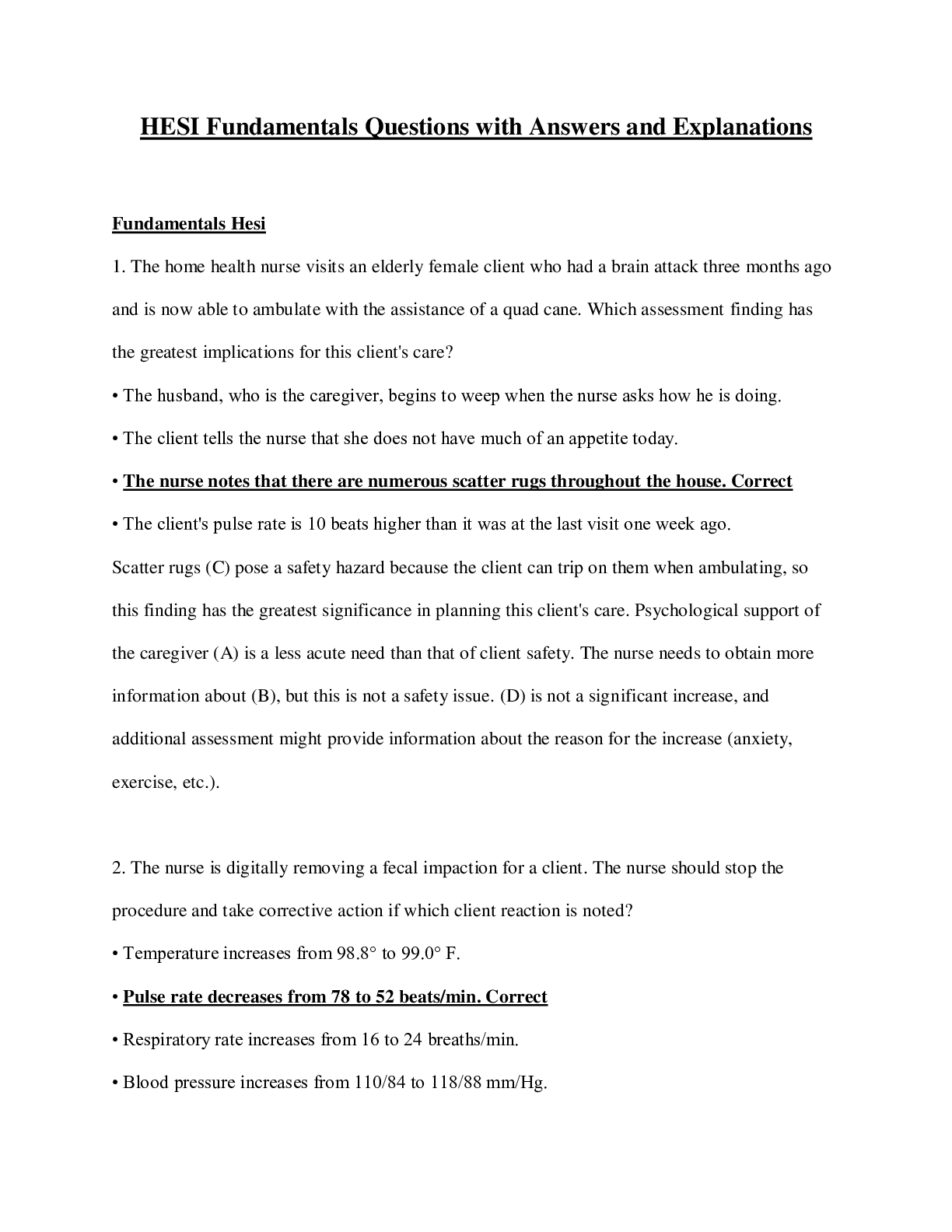
Reviews( 0 )
Document information
Connected school, study & course
About the document
Uploaded On
Feb 20, 2021
Number of pages
34
Written in
Additional information
This document has been written for:
Uploaded
Feb 20, 2021
Downloads
0
Views
39

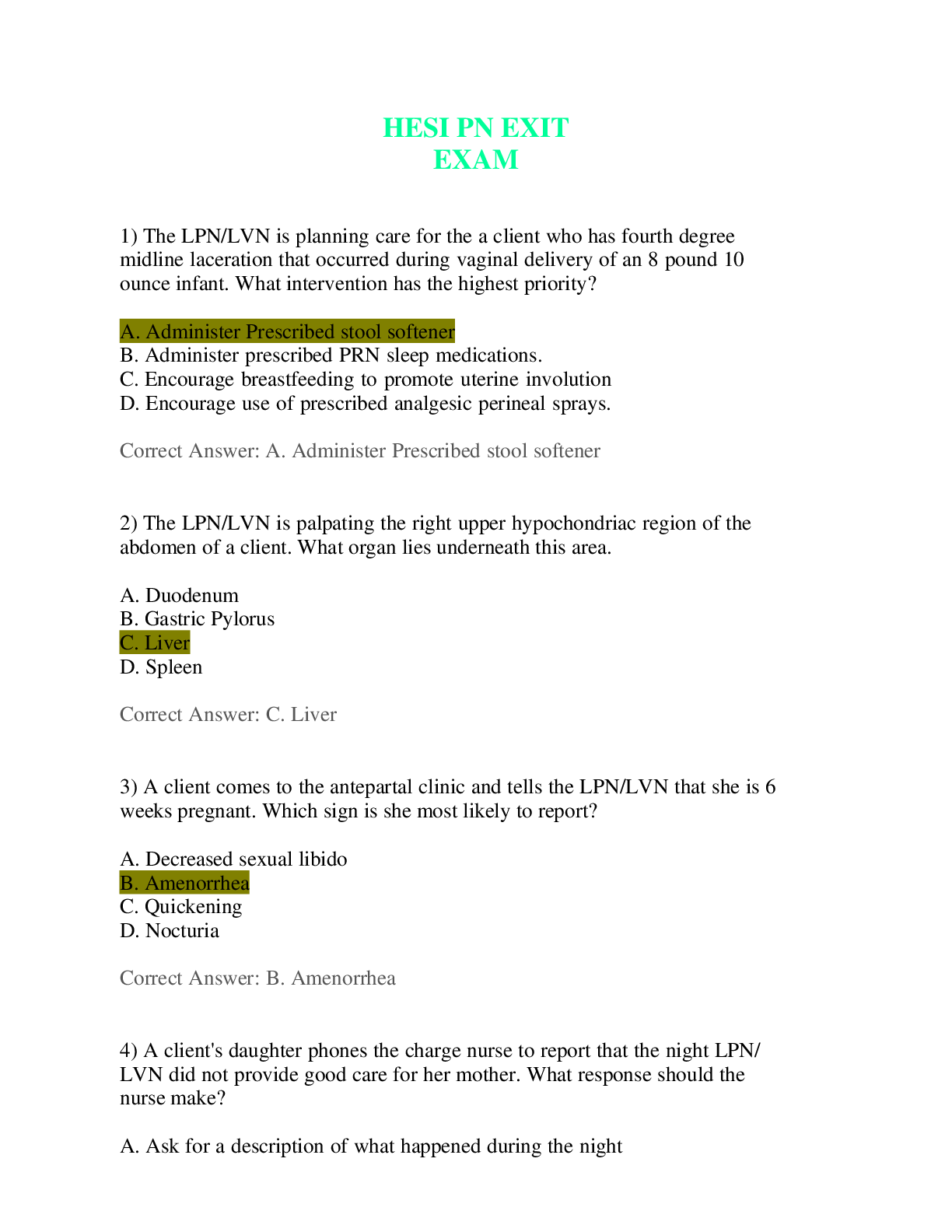

.png)
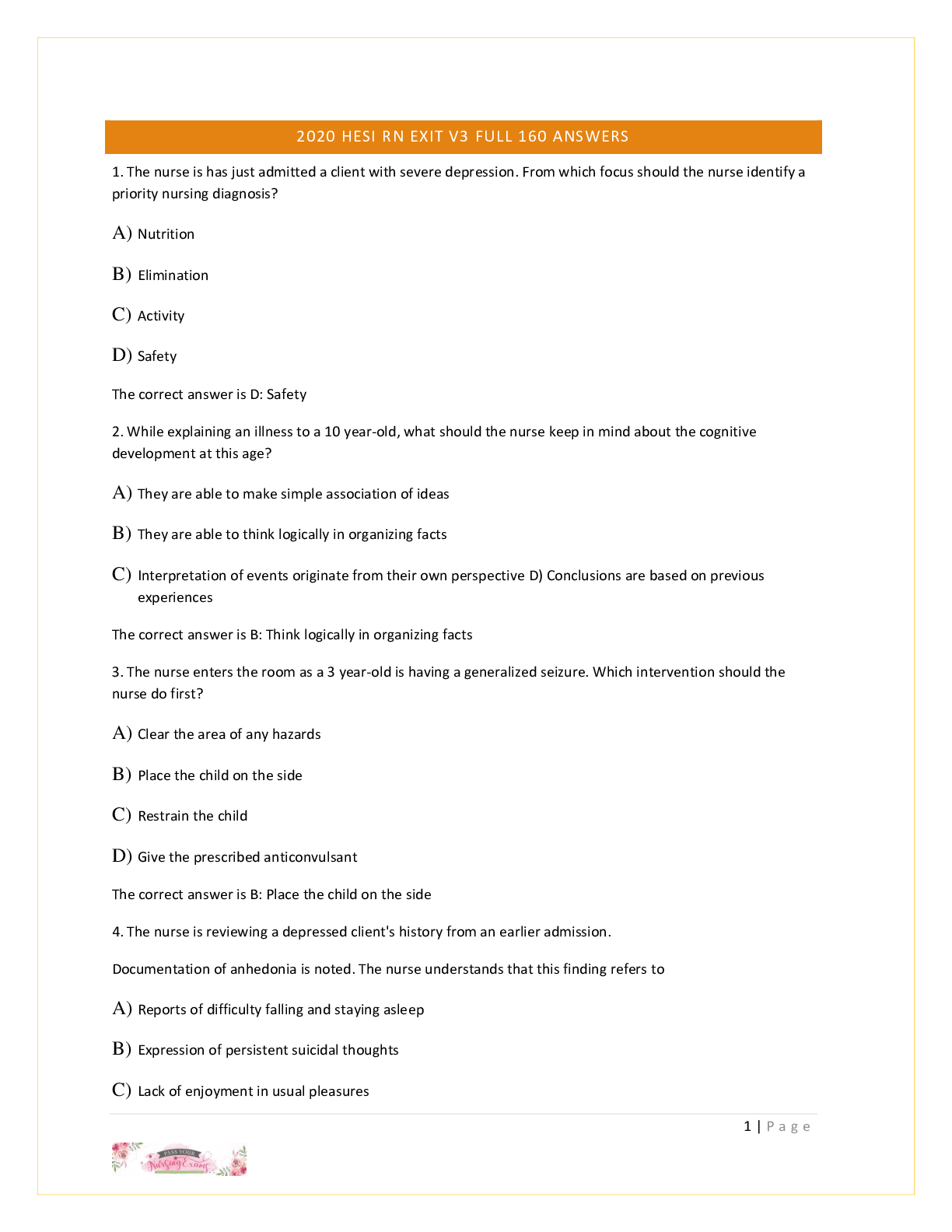

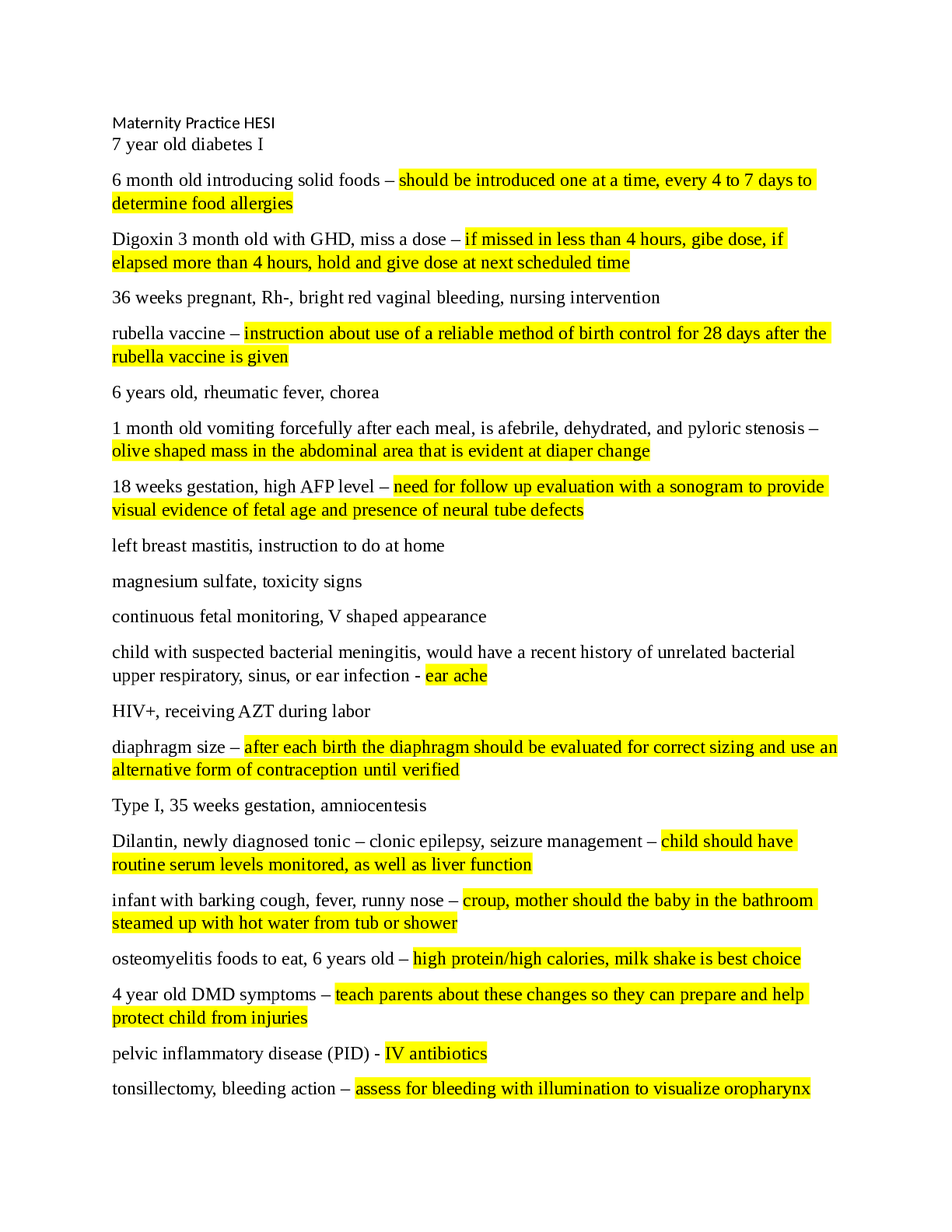
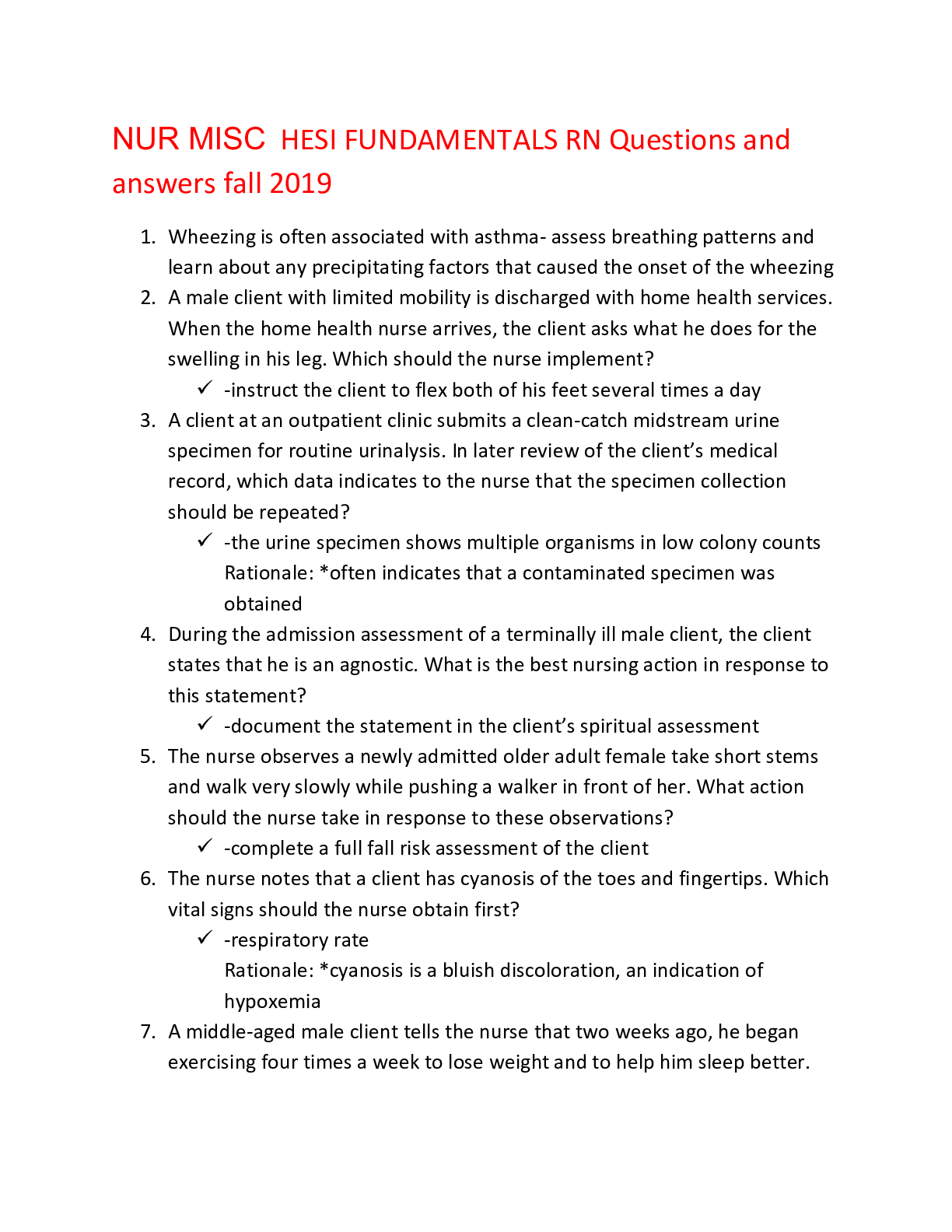

.png)
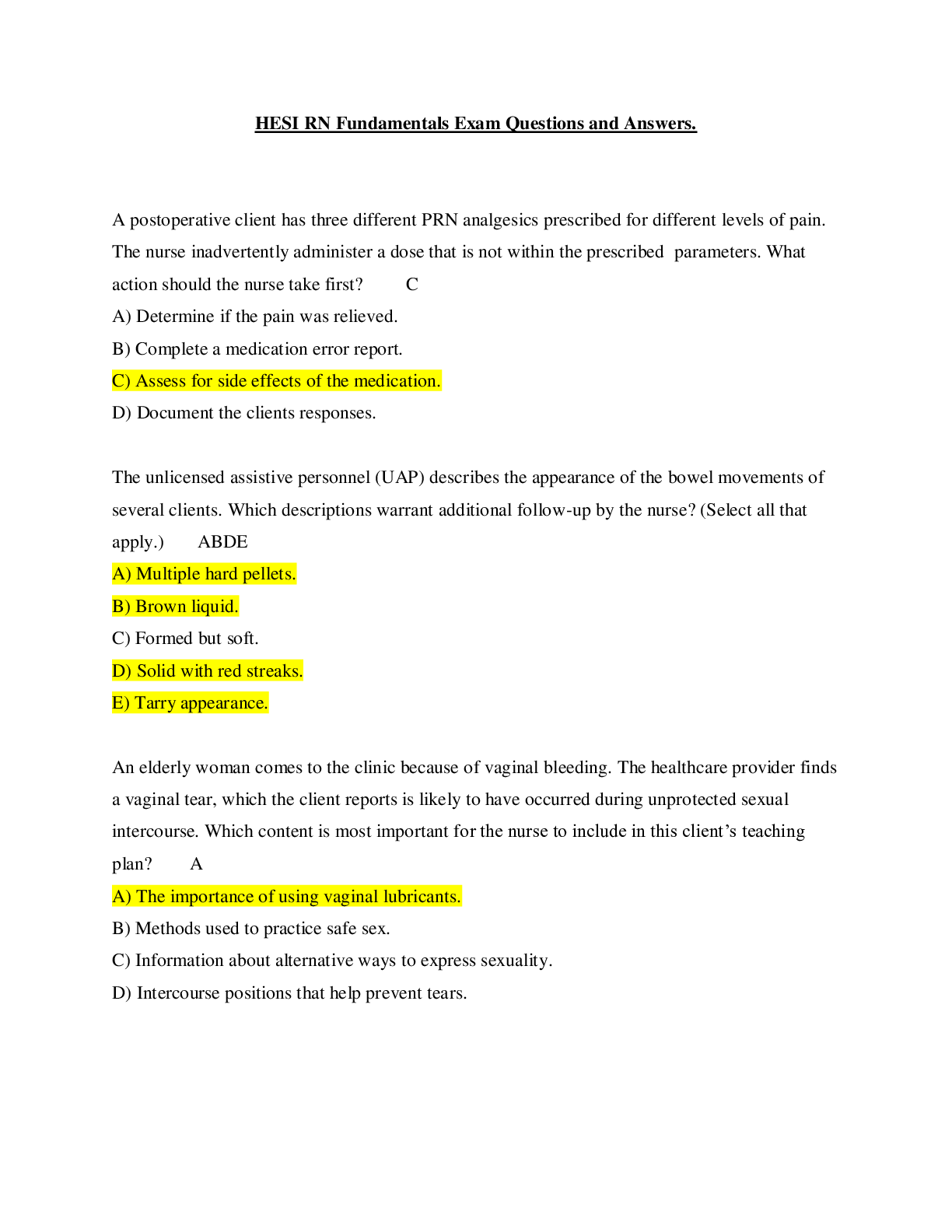
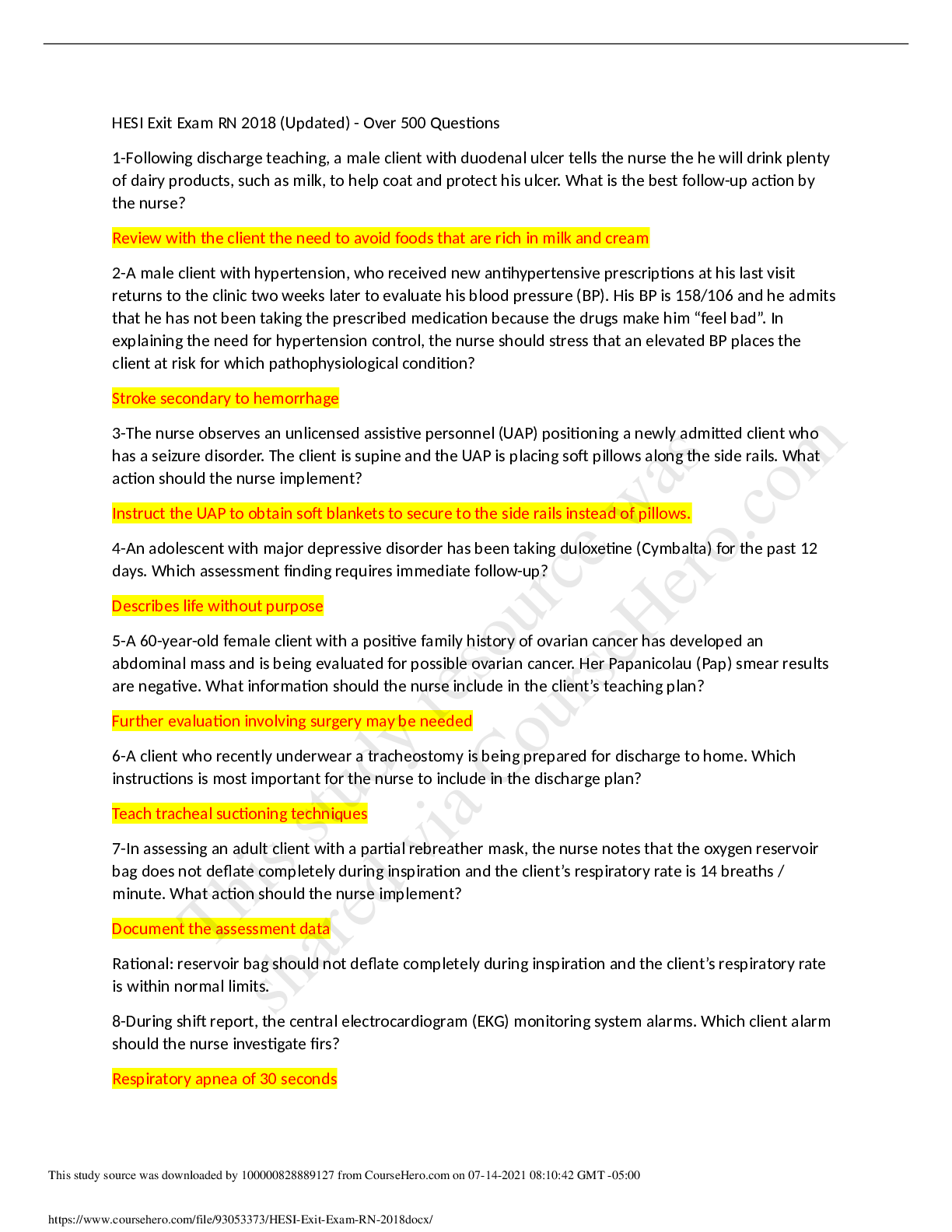


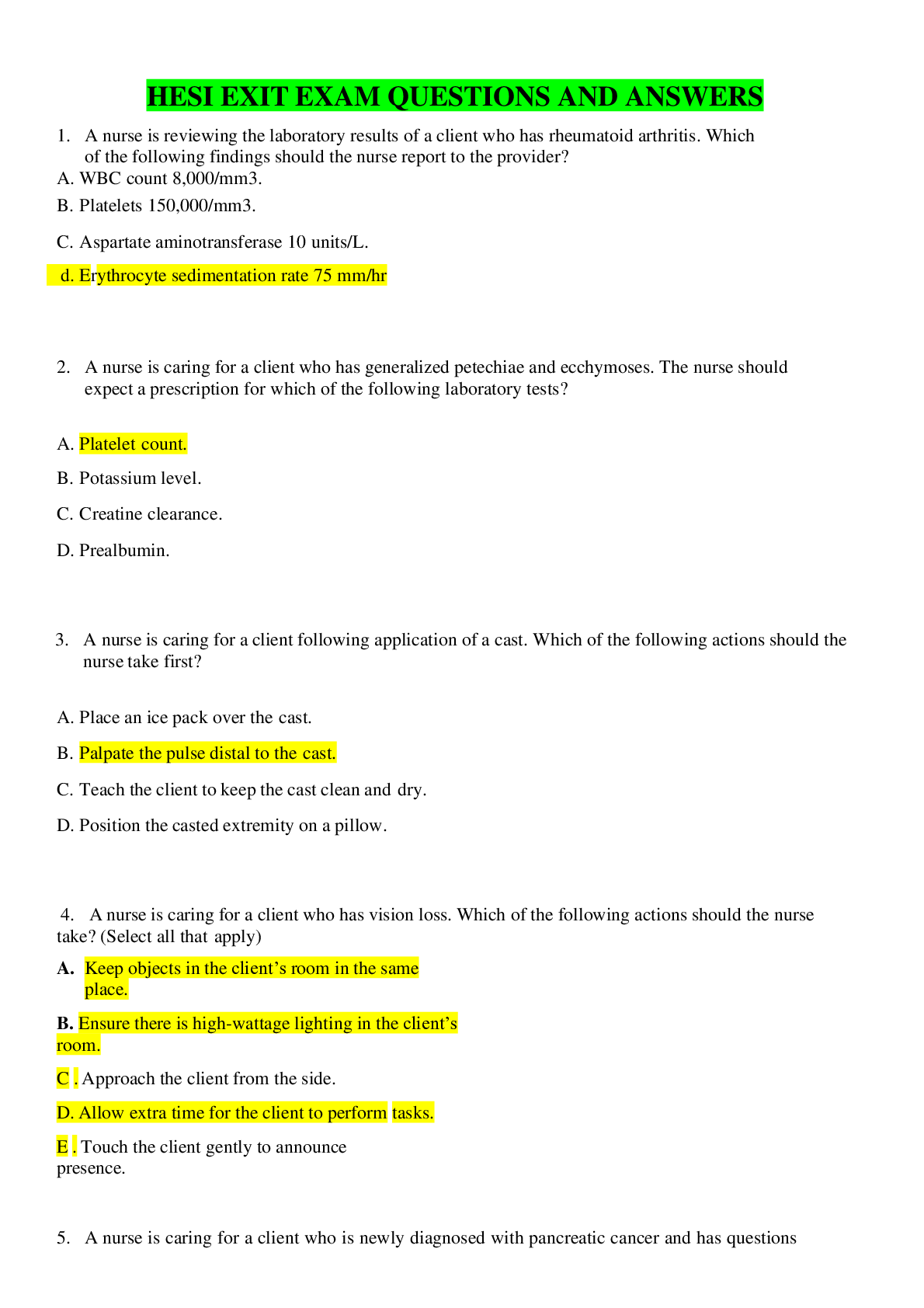

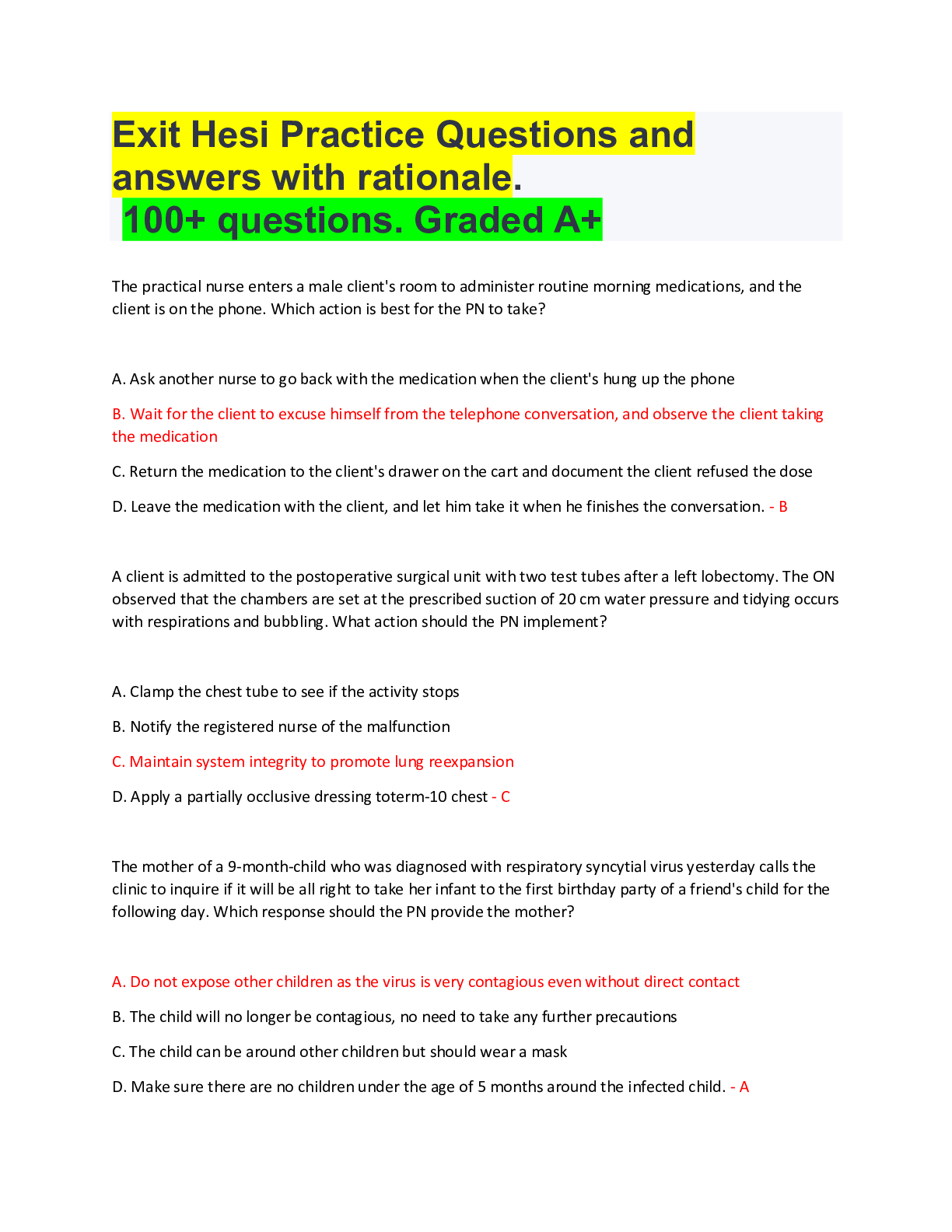
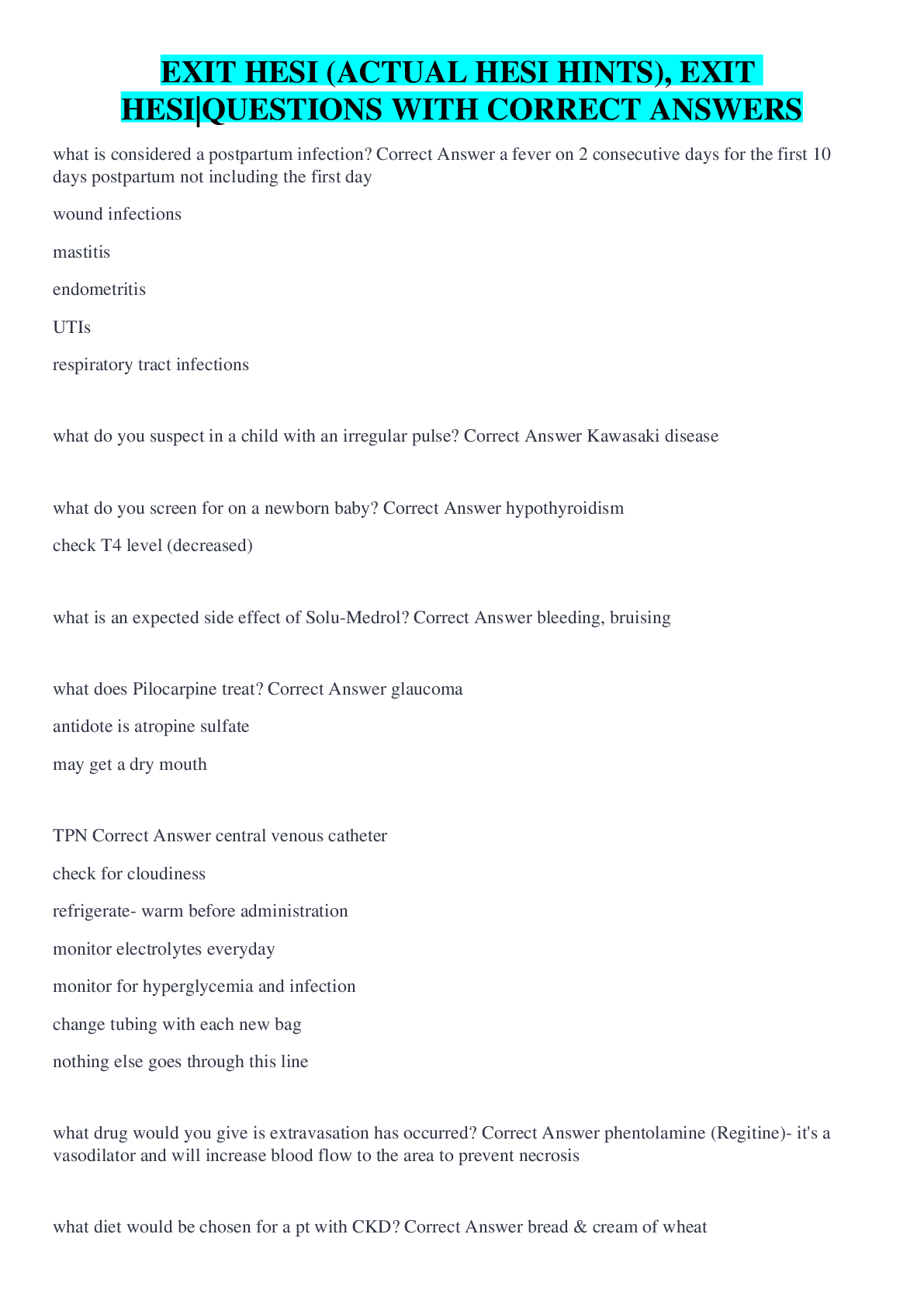
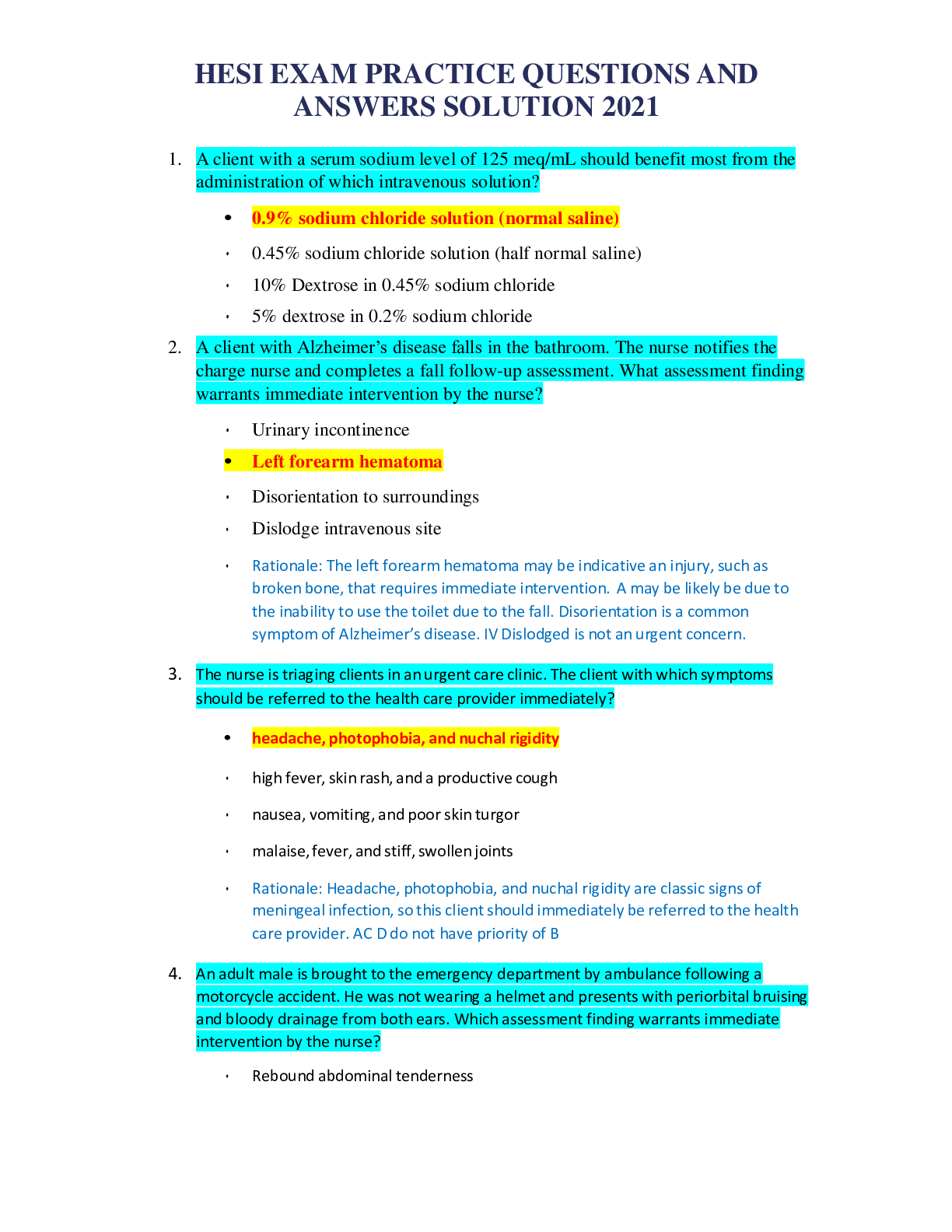
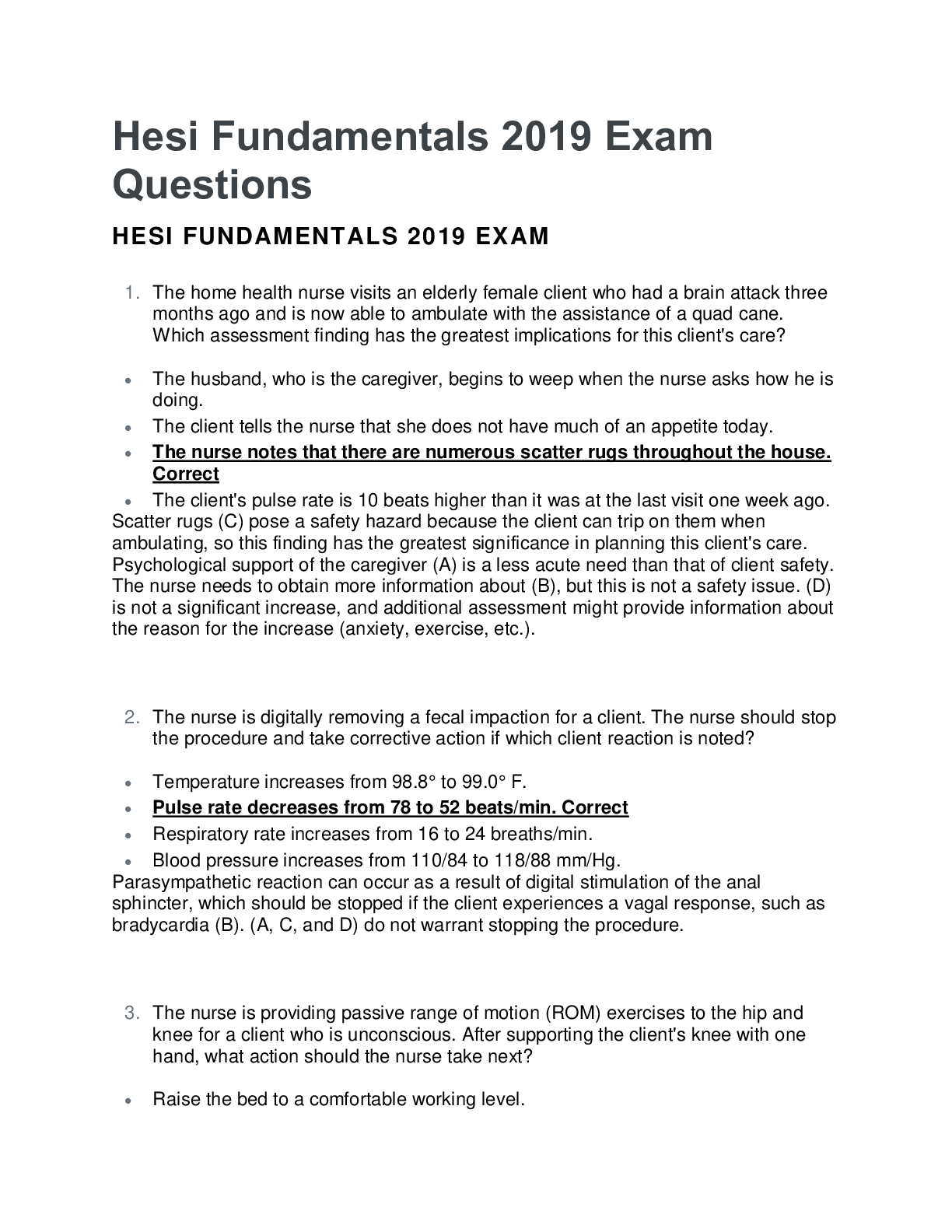
.png)
.png)
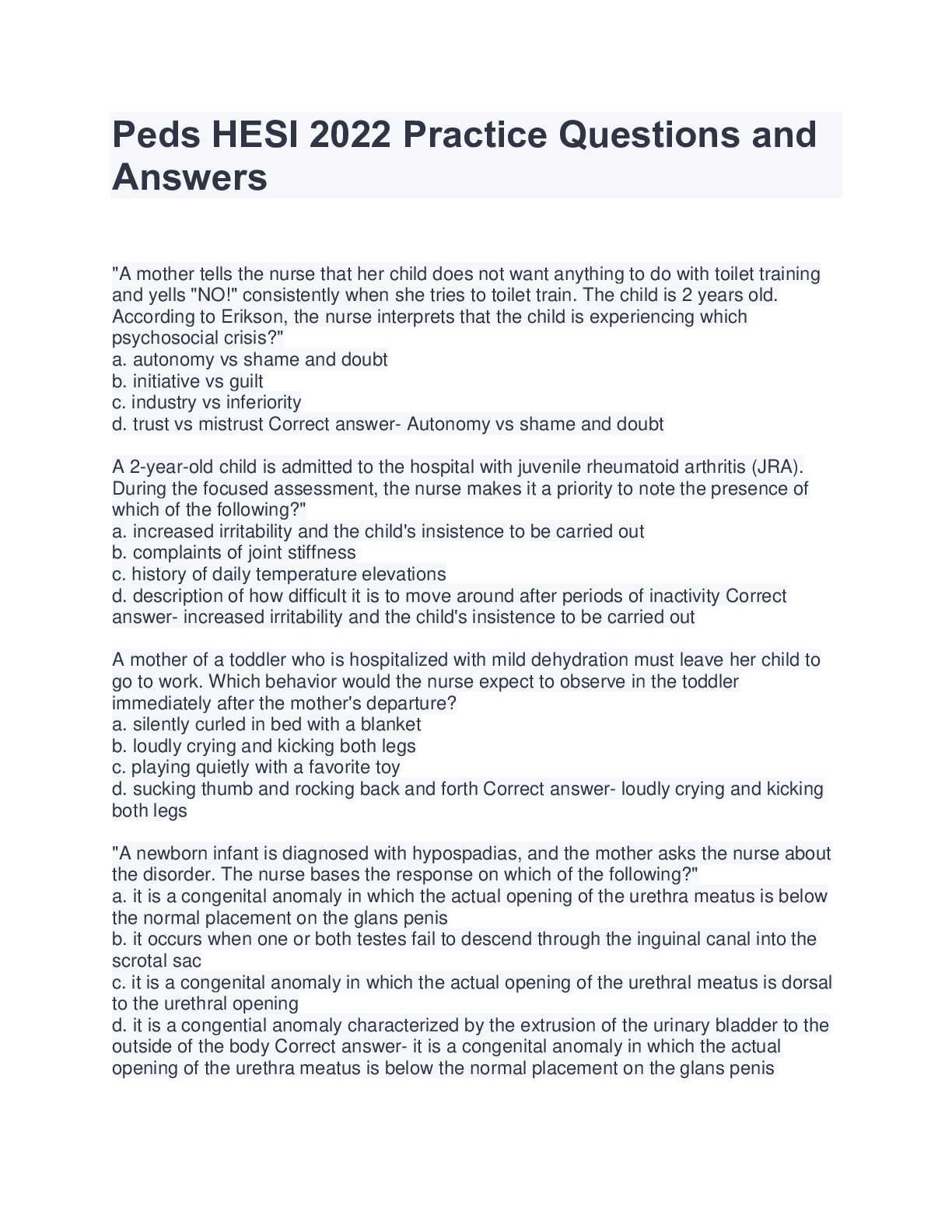
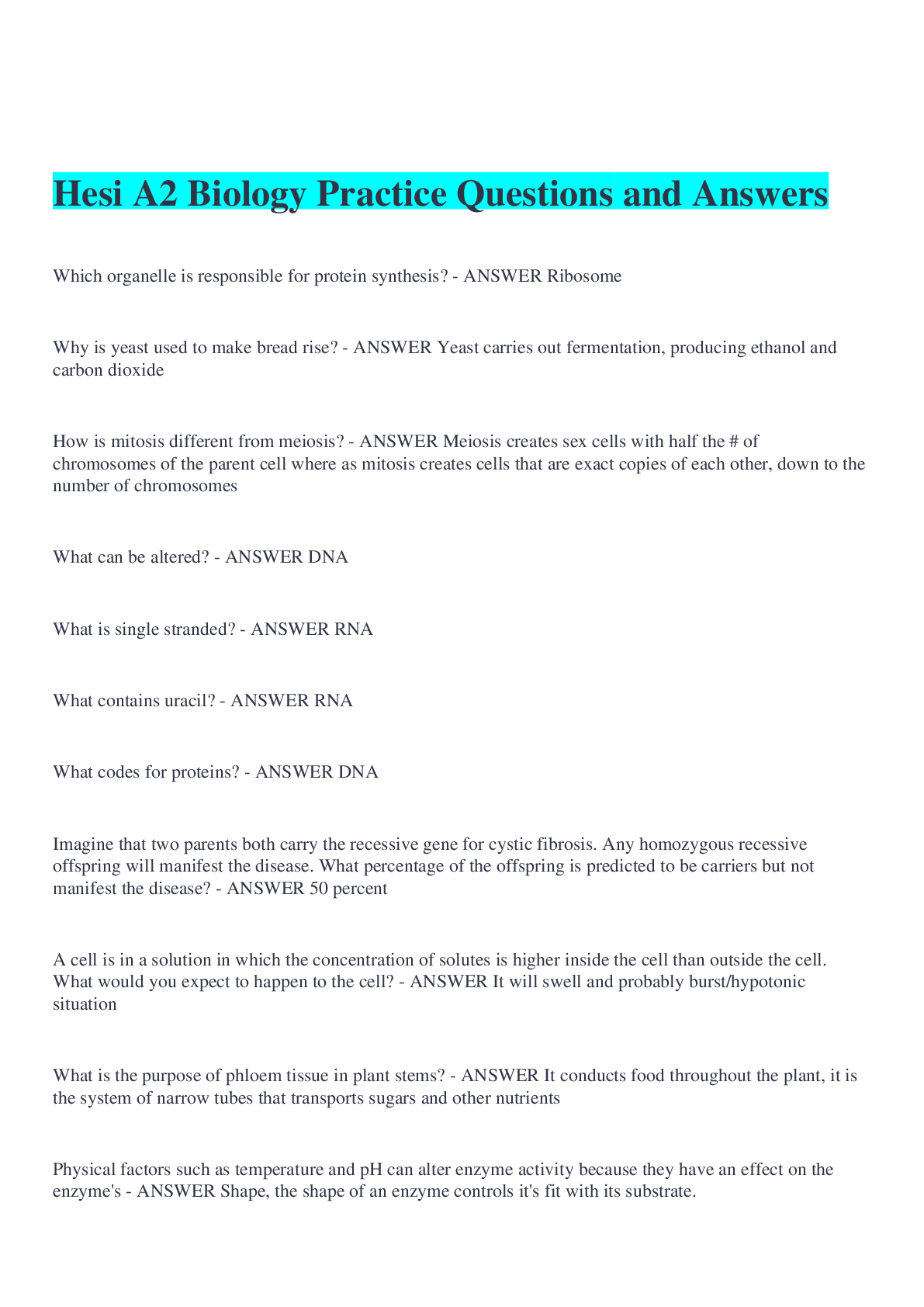
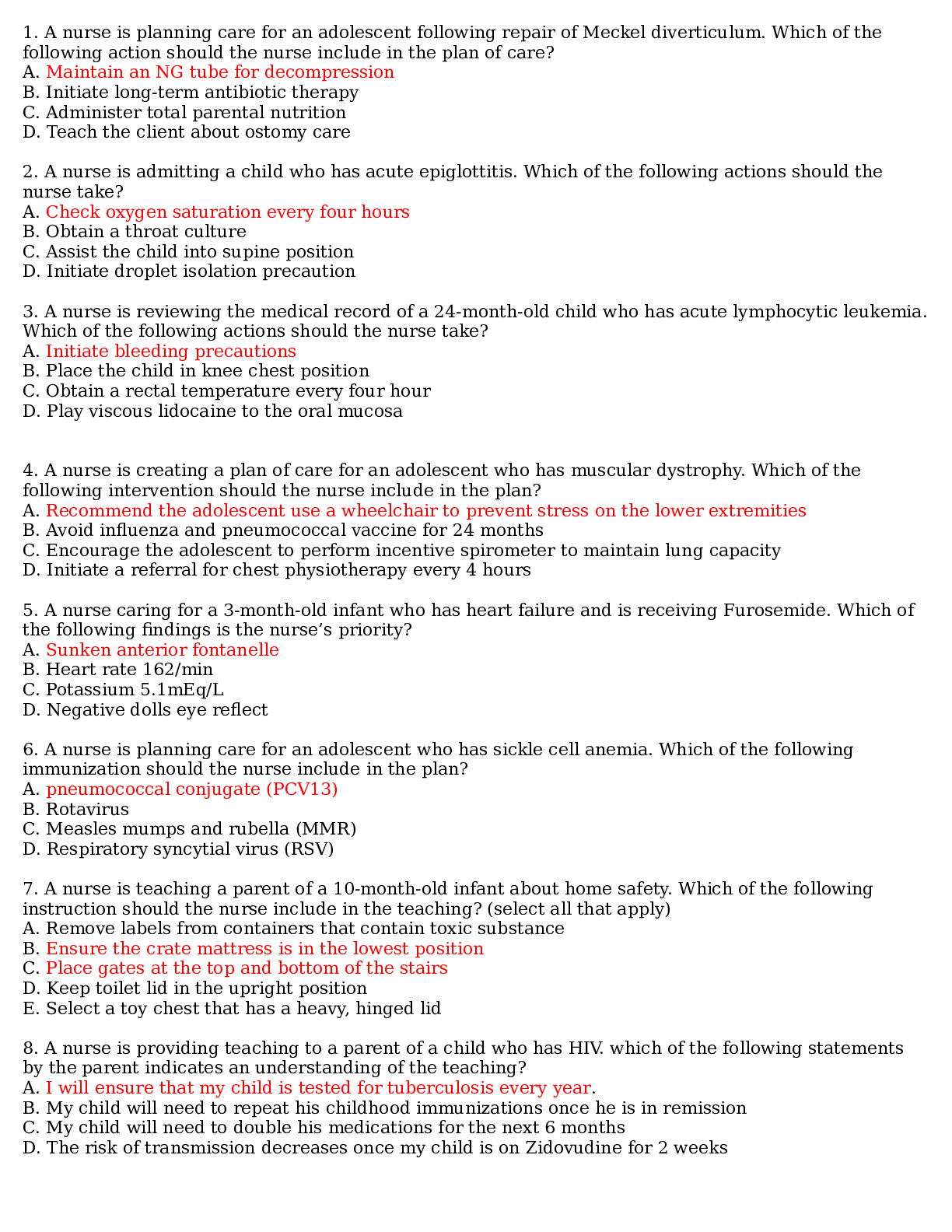

.png)
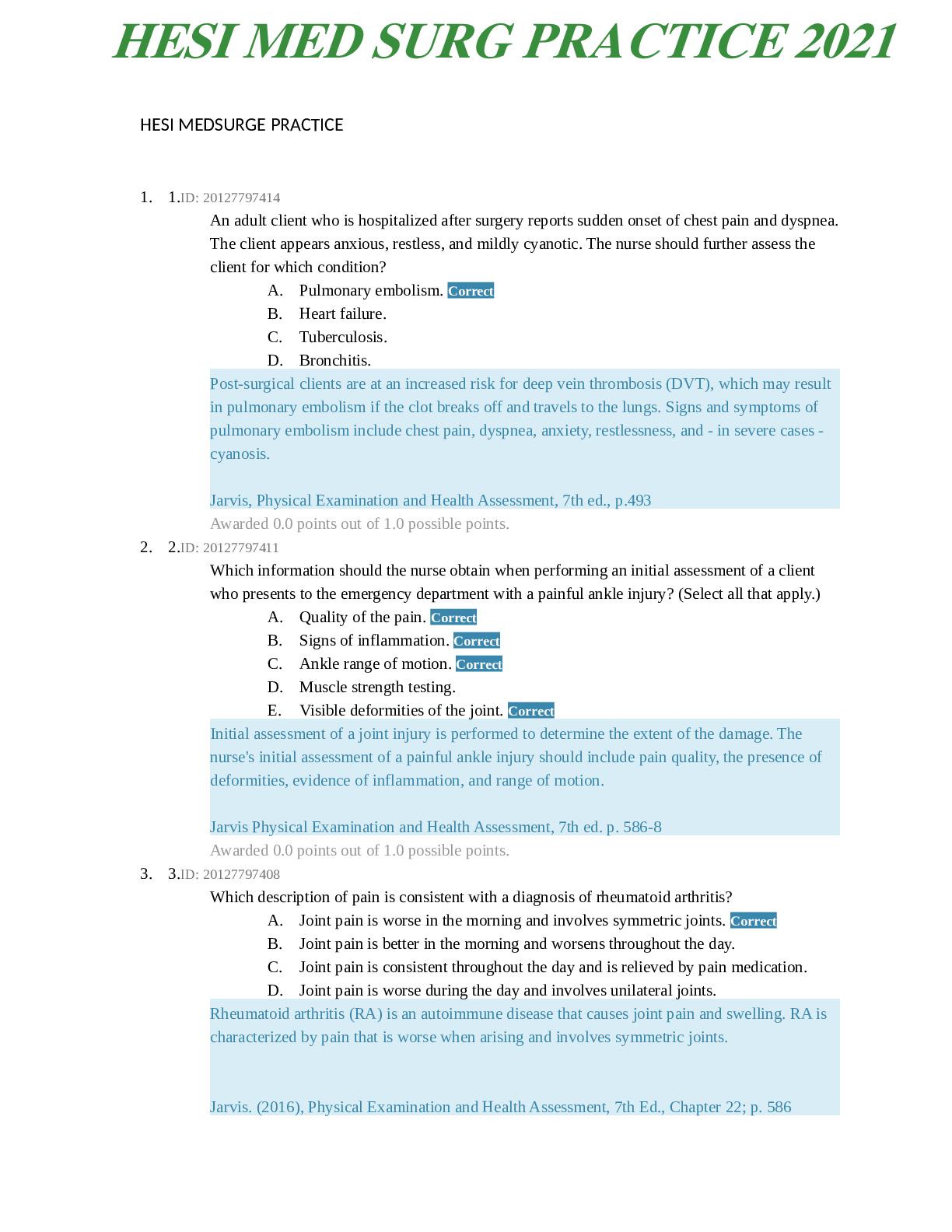
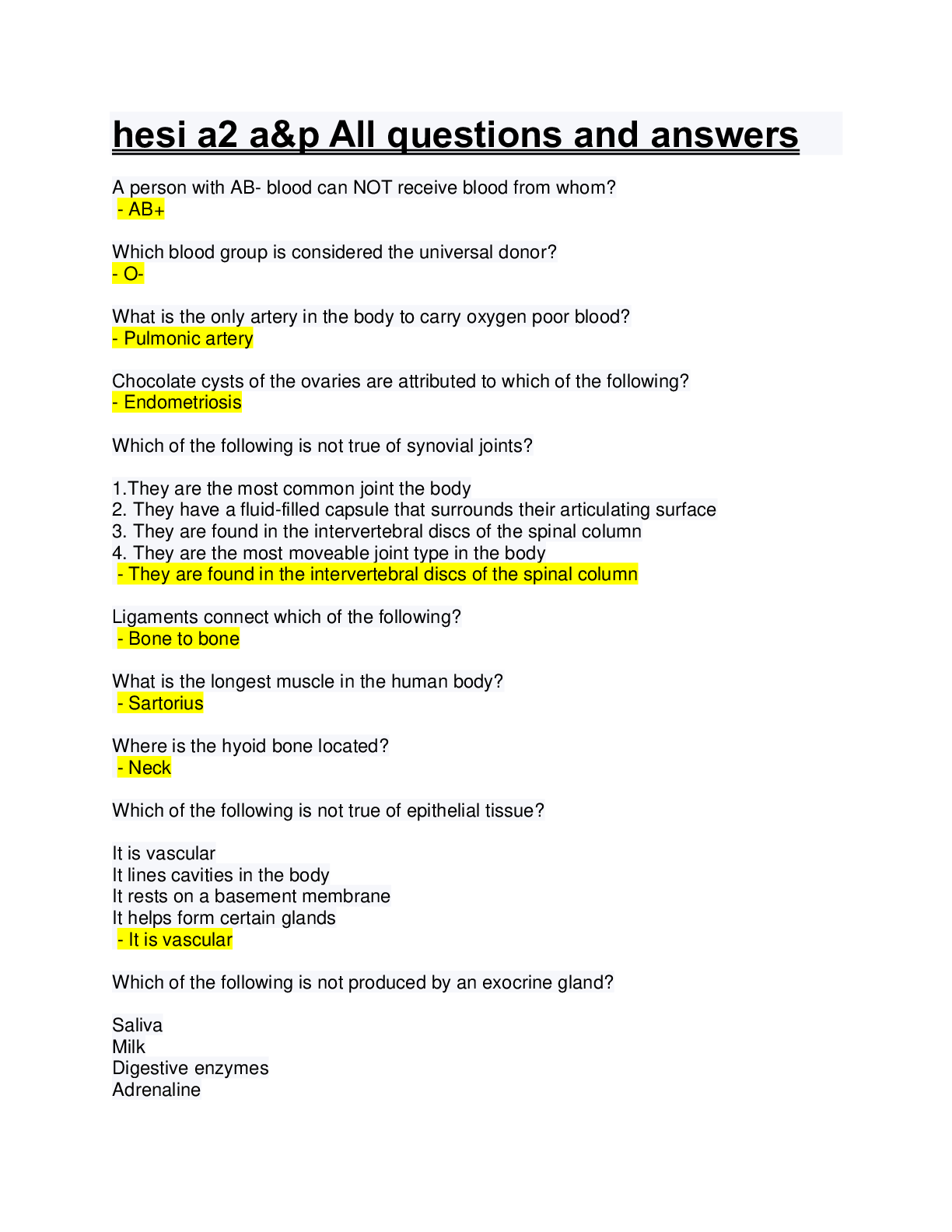
.png)
